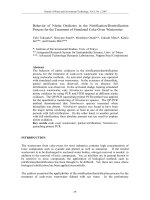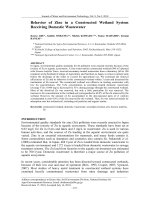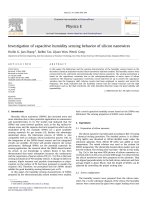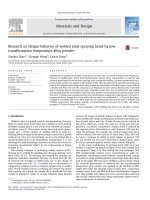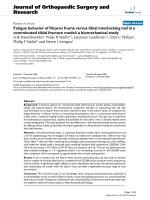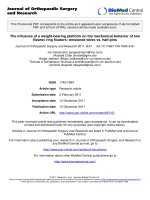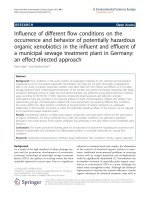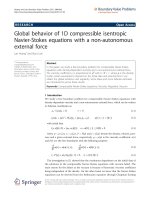Postbuckling behavior of functionally graded sandwich shallow spherical shells
Bạn đang xem bản rút gọn của tài liệu. Xem và tải ngay bản đầy đủ của tài liệu tại đây (511.3 KB, 3 trang )
KHOA H“C & C«NG NGHª
Postbuckling behavior of functionally graded sandwich
shallow spherical shells
Ứng xử sau vồng của các vỏ cầu thoải sandwich làm từ vật liệu có cơ tính biến đổi
Hoàng Văn Tùng
Tóm tắt
Bài báo giới thiệu một cách tiếp cận
giải tích để nghiên cứu ứng xử sau vồng
của các vỏ cầu thoải sandwich với các
lớp mặt làm từ vật liệu cơ tính biến
đổi, tựa trên nền đàn hồi và chịu áp lực
ngoài phân bố đều. Các tính chất vật
liệu của các lớp mặt được biến đổi qua
chiều dày theo quy luật hàm lũy thừa
dưới dạng các tỷ lệ thể tích của các vật
liệu thành phần. Các phương trình cơ
bản được thiết lập dựa trên lý thuyết vỏ
biến dạng trượt bậc nhất có kể đến tính
phi tuyến hình học và nền đàn hồi loại
Pasternak. Nghiệm xấp xỉ được chọn để
thỏa mãn điều kiện biên ngàm cứng và
phương pháp Galerkin được áp dụng
để dẫn ra các biểu thức hiển của liên hệ
tải-độ võng và từ biểu thức này ứng xử
sau vồng của vỏ được phân tích
Từ khóa: Vỏ cầu thoải, Cấu trúc sandwich,
Nền đàn hồi, Ứng xử sau vồng
Abstract
This paper presents an analytical approach
to investigate the postbuckling behavior of
Sandwich Shallow Spherical Shell (SSSS)
with functionally graded face sheets resting
on elastic foundations and subjected to
uniform external pressure. Effective material
properties of face sheets are graded in
the thickness direction according to a
simple power law distribution in terms of
volume fractions of constituents. Governing
equations are based on first order shear
deformation shell theory taking into account
geometrical nonlinearity and Pasternak
elastic foundations. Approximate solutions
are assumed to satisfy immovably clamped
boundary condition and Galerkin method
is applied to derive explicit expressions of
load-deflection relation from which the
postbuckling behavior the shells is analyzed.
Keywords: Shallow spherical shell, Sandwich
structures, Postbuckling behavior.
1. Introduction
Sandwich-type structures exhibit a number of exceptional features such as
increased bending stiffness with little resultant weight penalty, excellent thermal and
sound insulation, and extended operational life. Due to these outstanding properties,
the sandwich-type constructions play a great role as major portions in the construction
of advanced supersonic and hypersonic space vehicles [1]. The sandwich structures
are also used widely in building constructions and shipbuilding industry. Nonlinear
response and postbuckling of anisotropic and laminated flat and curved sandwich
panels have received researching interest in past years [2]. Functionally Graded
Material (FGM) is advanced composite material with many excellent characters. The
effective properties of the FGM are varied smoothly and continuously across the
thickness direction of the structures. Thus, FGM can avoid huge stress concentration
and interface problems of conventional laminated composites. The nonlinear response
and postbuckling of FGM sandwich plates and shells are important problems and
should be addressed. Linear buckling behaviors of FGM sandwich plates under
compressive and thermal loads have been investigated by Zenkour [3] and Zenkour
and Sobhy [4] using an analytical method. Shen and Li [5] employed a semi-analytical
approach based on a two-step perturbation technique to deal with the postbuckling
behavior of FGM sandwich plates under mechanical and thermomechanical loads.
Tung [6] investigated the thermal and thermomechanical postbuckling behavior of
FGM sandwich plates making use of Galerkin method and an iteration algorithm.
Structural elements in the form of spherical shells are widely used in engineering
structures. Tung [7] analyzed the nonlinear response of FGM spherical shells under
uniform external pressure in thermal environments taking into account temperature
dependence of material properties. Recently, Tung [8] presented an analytical study on
the nonlinear stability of FGM shallow spherical shells subjected to external pressure
with tangential edge constraints.
This paper extends the previous works [7,9] to investigate the postbuckling
behavior of FGM sandwich shallow spherical shells resting on elastic foundations and
subjected to uniform external pressure. Analytical solutions are assumed and Galerkin
method is applied to obtain explicit expression of load-deflection relation from which
the nonlinear stability of the shells are analyzed.
2. Sandwich Shallow Spherical Shell (SSSS) on an elastic foundation
Consider a FGM SSSS of radius of curvature R, base radius a, total thickness h
and rise of shell H. The shell is immovably clamped at boundary edge and rested on
a Pasternak elastic foundation as shown in Fig. 1. The SSSS is constructed from two
functionally graded material (FGM) face sheets (i.e. skins) separated by a thicker core
layer made of metal material.
P
FGM
METAL
FGM
hf
h
20
H
h0
h1
z,w
hf
h2
h3
k2
k1
TS. Hoàng Văn Tùng
Faculty of Civil Engineering
Hanoi Architectural University
Email:
ϕ,u
R
r
a
Fig. 1. Geometry and coordinate system of a FGM SSSS on an elastic
foundation.
T„P CHŠ KHOA H“C KI¦N TR”C - XŸY D¼NG
It is assumed that core and face layers are perfectly
bonded and the thickness of each face sheet is . The top
skin varies from a ceramic-rich surface ( ) to a metal-rich
interface, whereas the bottom skin is graded from a metalrich interface to ceramic-rich surface ( ). Such a configuration
of FGM sandwich shell is mid-plane symmetric and the
volume fraction of the metal constituent is obtained by power
law distribution as
σ rz =
E
ε rz
2(1 + ν ) .
( N r , Nθ ) =
(1)
where Emc=Em-Ec and Em, Ec are elastic moduli of metal
and ceramic constituents, respectively. Poisson ratio
is
assumed to be a constant in the present study. The FGM
SSSS is rested on an elastic foundation and shell-foundation
interaction is represented by Pasternak model as
2
2
(3)
where ∆ =
∂ / ∂x + ∂ / ∂y is Laplace’s operator, w is
deflection of shell; k1 is modulus of Winkler foundation, k2 is
stiffness of shear layer of Pasternak foundation model.
3. Formulations
The first order shear deformation shell theory (FSDT)
is used to formulate for the present study. The FGM SSSS
is assumed to be under axisymmetric deformation and
displacement components u , v , w in ϕ ,θ , z directions,
respectively, at a distance z from the middle surface are
represented as [7]
u (r=
, z ) u (r ) + zψ (r ) , v (r , z ) = 0 , w(r , z ) = w(r ) (4)
in which r = R sin ϕ , u is displacement in the meridional
direction at the middle surface, w is the deflection of the shell,
and ψ is the rotation of a normal to the middle surface. Due
to shallowness of the shell, it is approximately assumed that
cos ϕ = 1 , Rdϕ = dr and R = a 2 / (2 H ) . The non-zero
strain components are
ε=
ε r 0 + z χ r , ε=
ε θ 0 + z χθ , ε rz= ψ + w,r
r
θ
(5)
where ( ), r = d ( ) / dr , and the strains at the middle
surface ε r 0 , ε θ 0 and curvatures χ r , χθ are related to the
displacements and rotation in the form
εr0 =
u, r − w / R + w,2r / 2 =
ε
u /r −w/ R,
, θ0
χ r = ψ ,r
,
χθ = ψ / r .
Based on Hooke law, stress-strain relations are
=
σr
E( z)
E( z)
ε + νε
=
(εθ + νε r )
θ ) σθ
2 ( r
1 −ν 2
1 −ν
,
,
,
[ E1 , E2 ]
,Mr ]
[ Nr =
(ε r 0 + νεθ 0 ) +
1 −ν
[ E1 , E2 ]
2
, Mθ ]
[ Nθ =
1 −ν 2
(εθ 0 + νε r 0 ) +
∫
σ rz dz
−h/2
[ E2 , E3 ]
(8)
( χ r + νχθ )
1 −ν 2
[ E2 , E3 ]
1 −ν 2
( χθ + νχ r )
K S E1
(ψ + w,r )
2(1 + ν )
.
h/2
where
[ E1 , E2 , E3 ] = ∫
−h/2
,
,
(9)
E ( z ) 1, z , z 2 dz (10)
The nonlinear equilibrium equations of a FGM SSSS
resting on an elastic foundation based on the FSDT are [7,8]
( rN r ),r − Nθ
=
0 ( rM r ), r − M θ − rQr =
0
,
,
r
R
0
( rQr ),r + ( N r + Nθ ) + ( rN r w,r ),r + r ( P − q f ) =
(11)
where is external pressure uniformly distributed on the
outer surface of shell.
The FGM SSSS is assumed to be clamped and immovable
in the meridional direction at the boundary edge, and under
axisymmetric deformation. The symmetry condition at the
center and boundary conditions at are expressed as [6,7]
ψ =0
at
r = 0 ; w = 0 , ψ = 0 , u = 0 at r = a . (12)
To satisfy conditions (12), the
solutions are assumed [7,9]
u =U
following approximate
r (a − r )
r (a 2 − r 2 )
ψ= Ψ
2
a
a3
,
,
(a
w =W
2
− r2 )
2
a4
(13)
where are coefficients to be determined, is the deflection
amplitude. Now, solutions (13) are substituted into Eqs. (11)
and Galerkin method is applied for the resulting equations
a
(6)
,
h/2
Qr = K S
where is shear correction coefficient. Introduction of Eqs.
(7) into Eqs. (8) gives the expressions of force and moment
resultants as
E( z) =
EmVm ( z ) + EcVc ( z ) =
Ec + EmcVm ( z ) =
(2)
Qr
,σ θ )dz
−h/2
Herein h0=-h/2, h1=-h/2+hf, h3=h/2 and n≥0 is volume
fraction index. Volume fraction of ceramic constituent is
defined as Vc(z)=1-Vm(z). Effective modulus of elasticity of
the FGM SSSS is determined by linear rule of mixture as
2
r
( M r , M θ ) = ∫ (σ r ,σ θ )zdz
n
2
∫ (σ
h/2
z − h3
Vm ( z ) =
z ∈ [h2 , h3 ] bottom skin
h2 − h3 ,
q f = k1w − k2 ∆w
h/2
−h/2
n
z − h0
Vm ( z ) =
z ∈ [h0 , h1 ] top skin
h1 − h0 ,
Vm ( z ) = 1 ,
z ∈ [h1 , h2 ] core layer
(7)
The force and moment resultants are expressed in terms
of the stress components
a
0 ∫ L2 r (a 2 − r 2 )dr =
0
∫ L1r (a − r )dr =
,
0
a
∫ L (a
3
2
0
,
− r 2 ) 2 dr =
0
(14)
0
where
L1 , L2 , L3 are the
resulting expressions obtained
S¬ 27 - 2017
21
KHOA H“C & C«NG NGHª
60
45
1: n = 0
2: n = 1
a/h = 20, H/a = 0.15
50 hf/h = 0.2, (K1,K2) = (0,0)
40
3: n = 3
35
4: n = 10
30
2
5
1
2
W/h
3
100
n = 2, a/h = 20, hf/h = 0.2
(K ,K ) = (0,0)
1
2
0
0
4
Fig. 2. Effects of volume fraction index on the
postbuckling of the SSSSs.
120
2
4
3
2
1
20
10
1
0
0
1
25
15
20
10
(K ,K ) = (0,0)
30
4
3
P (MPa)
P (MPa)
40
a/h = 20, H/a = 0.15, n = 1
1: hf/h = 0.1
2: hf/h = 0.15
3: h /h = 0.2
f
4: hf/h = 0.25
1
2
W/h
3
Fig. 3. Effects of the hf/h ratio on the postbuckling of
the SSSSs.
60
1: H/a = 0.1
2: H/a = 0.125
3: H/a = 0.15
50
4: H/a = 0.175
40
P (MPa)
P (MPa)
4
5: H/a = 0.2
80
5
60
4
40
30
20
3
2
1
20
4
3
2
1: (K ,K ) = (0,0)
1
2
2: (K1,K2) = (50,0)
1
3: (K1,K2) = (80,0)
4: (K1,K2) = (60,5)
10
n = 2, a/h = 20, H/a = 0.175, h /h = 0.2
f
0
0
1
2
W/h
3
Fig. 4. Effects of the H/a ratio on the postbuckling of
the SSSSs.
by substituting (13) into the left sides of Eqs. (11), respectively.
Eqs. (14) are system of nonlinear algebra equations in term
of U, Ψ, W. Next, eliminating U and Ψ from these equations
yields the following nonlinear relation of external pressure P
and deflection amplitude W as
2
P =e31W + e32 W + e33W
3
(15)
e31 , e32 , e33 can be
where W = W / h and coefficients
found in the work [7].
4. Results and discussion
This section presents numerical results for FGM SSSS
made of aluminum (metal) and alumina (ceramic) with the
following properties Em = 70 GPa and Ec = 380 GPa, and
Poisson ratio ν = 0.3 for both constituents. Reliability of
proposed approach has been verified in the previous work
[7].
Fig. 2 examines the effects of volume fraction index
n(=0 ,1,3 and 10) on the postbuckling of FGM SSSSs
without foundation interaction. It is evident that FGM SSSSs
exhibit extreme-type buckling behavior and an unstable
postbuckling response with relatively intense snap-through
22
0
0
4
1
2
W/h
3
4
Fig. 5. Effects of elastic foundations on the
postbuckling of the SSSSs.
phenomenon. Specifically, buckling loads, load-deflection
curves and intensity of snap-though instability (measured by
difference between upper and lower pressures at limit points)
are all increased. Next, the effects of face sheet thickness
hf-to-total thickness h ratio (hf/h=0.1, 0.15, 0.2 and 0.25) on
the postbuckling of FGM SSSSs are shown in Fig. 3. As can
be seen, buckling loads and postbuckling strength of FGM
SSSSs are remarkably improved when the thickness of FGM
face sheet is increased.
The effects of rise-to-base radius H/a ratio and nondimensional stiffness of elastic foundations K1, K2 on
the postbuckling behavior of FGM SSSSs subjected
to uniform external pressure are considered in figures
4
and
5,
herein
=
K1 12(1 − ν 2 )a 4 k1 / E1h 2 and
2
2
2
=
K 2 12(1 − ν )a k2 / E1h .
Fig. 4 indicates that H/a ratio has very sensitive influences
on the nonlinear response of FGM SSSSs. Specifically,
external pressure-deflection curves are pronouncedly
enhanced as H/a ratio is increased. However, this increase
in (limit-type) buckling loads is accompanied by a severe
snap-through instability in postbuckling region. Finally,
T„P CHŠ KHOA H“C KI¦N TR”C - XŸY D¼NG
(xem tiếp trang 26)
